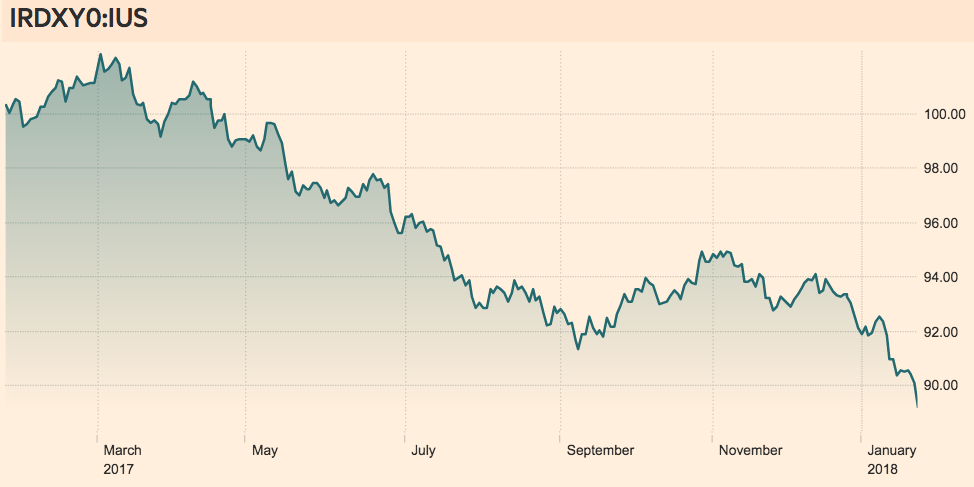At the beginning of 2017, it cost $1.06 (USD) to buy one euro. As of today, $1.235 is needed to buy the same euro. Does that reflect US economic weakness or just EU strength? How about the greenback against the British pound? In early 2017 it cost $1.24 to buy the British pound; now the same thing costs $1.40. The graph below demonstrates the dollar weakness against a basket of major currencies.

Source: Financial Times. Retrieved January 24, 2017.
For an individual who invests internationally in a global economy that is experiencing synchronized growth, the dollar weakness translates into higher gains and enhances portfolio returns. However, a potential strengthening of the dollar against the euro and other major currencies would imply that higher prices for foreign stocks are translated into lower gains at home (the US), and thus the investor would be tempted to diversify away from international securities.
The fact is that in a wave of synchronized global growth and especially when valuations are lower abroad, it pays “double” to invest internationally given the dollar weakness. Therefore, we could say that capital movements and international diversification are significant forces in driving the dollar down.
However, let’s go back to the basics. Which are the main factors that determine the value/strength of the currency against other major currencies?
- First and foremost, the theory will tell us that other things being equal, the major factor would be interest rate differentials. If the interest rates in the US are higher (as they are) than let’s say in the EU, logically we could conclude that the dollar should strengthen against the euro.
- Second, we should be looking at growth prospects. Again, the expectation for economic growth in the US surpasses that of the EU, UK, and Japan, and thus again we should conclude that the dollar logically should strengthen against the other major currencies.
- Third, we should consider special circumstances that attract capital, such as legislation. Again, the recent tax legislation in the US that reduces corporate tax rates and especially the provision for profits repatriation should lead us to the conclusion that the dollar should strengthen against other major currencies.
- Fourth, the higher oil prices advance the circulation of petrodollars which in turn should support a higher dollar index, especially when it is combined with higher US rates.
- Fifth, the fact that the ECB is still in more accommodative mode than the Fed should also contribute to the uplifting of the greenback.
- Sixth, a weak dollar advances commodities and hence promotes international trade which further contributes to synchronized growth while allowing economic weaknesses (such as non-performing loans and collateral holes) to either be hidden or partially addressed.
- Seventh, perceived credit inflation (expansionary policies) usually lead to currency weakness.
- Finally, political developments and the administration’s attitude towards the strength of the local currency are significant factors in determining the currency’s trajectory.
Given the above, what then should we say about the dollar’s trajectory in 2018 and what are the implications for investors?
Our opinion is that despite the factors that under normal circumstances should have contributed to the strengthening of the dollar, it is experiencing weakness for the following reasons:
- First, capital flows and international investments on behalf of US investors – given lower valuation abroad as well as the growth upswing in foreign markets – keep the dollar down.
- Second, the Trump administration’s protectionist attitude and tendency to suppress and talk down the dollar (as recently as yesterday when the administration officials were arriving at Davos) contributes significantly to dollar weakness.
- Third, expected credit inflation through infrastructure spending and higher US deficits is the de facto prolegomenon of currency weakness.
- Fourth, the expectation at the beginning of the year that dollar weakness would reverse in 2018, had some investors taking long positions on the dollar and shortening other currencies. The covering of the shorts contributes to the dollar weakness we are observing in the last few days.
- Fifth, geopolitical developments and the absence of economic statecraft/diplomacy in the US allow other countries to diversify their reserves away from the US. This should be a source of major concern to US officials. Cheapening one’s currency is not prudent economic policy and rather becomes the source/cause of major problems down the road.
What then could we say about the dollar’s trajectory and international portfolio diversification?
We expect the dollar to fluctuate between 1.18-1.25 against the euro (and similarly stay weak against other major currencies) for the next few months and thus international exposure could uplift portfolio earnings. However, we would not be surprised if in the second half of the year the dollar strengthens due to the Fed’s policies, the repatriation of profits (in the hundreds of billions) and the attractiveness of higher prospects in the US, which in turn may reduce the attractiveness of higher international exposure. However, such possible reversal may be cancelled due to the absence of economic statecraft on behalf of the US which so far has oiled the machinery of foreign currencies and is pushing international reserves away from the dollar.
